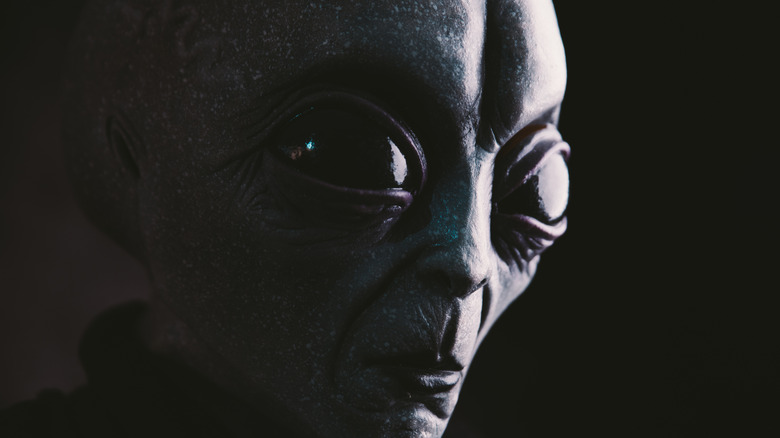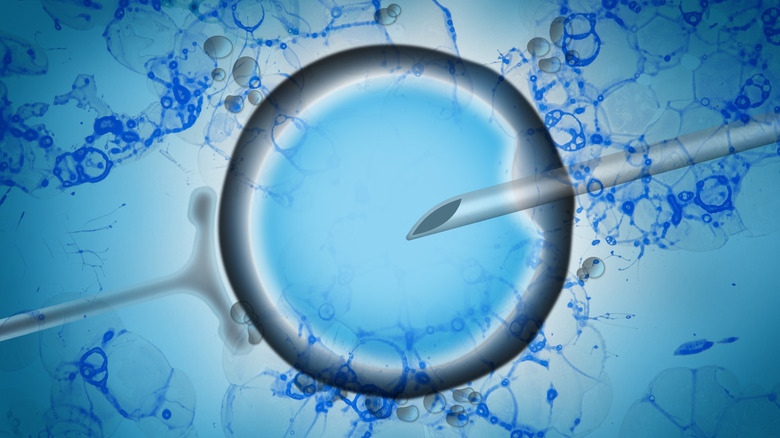What Humans Might Look Like In A Million Years
Predicting the future isn't something humans have ever been particularly good at. See the might of Rome? It will last forever, soldiers and emperors may have thought. A farmer in the French countryside in the 13th century would have envisioned a future precisely like his, ad infinitum. Folks alive in 2000 could never have foreseen the way the internet would evolve to twist and mince fundamental human communication into chunks of disembodied text and memes.
So is it actually possible to predict what humans might look like, physically, in one million years? Absolutely, positively, completely not. We don't even know what people are going to look like in 50 years. It's true that to a degree, we can envision biology's slow march based on known environmental factors. Rising global temperatures affect the body, for instance. Increased nutrition has made people larger, per Live Science. Disease prevention ensures the survival of those who would otherwise die. Genetics of racial groups are blending more and more, as Aeon explains.
The effects to the body made by incremental, biological changes are minimal in comparison to the impact of technology, though. One previous human species, Homo erectus, lived unchanged from a staggering 1.89 million to 110,000 years ago, as History reminds us. They didn't look too different from us, Homo sapiens — except a bit shorter, squatter, and hairier. People in the far distant future, though? We can only conjecture, but it's likely that they might not even be recognizable to us as "human."
The aliens who are us
The default vision of future humans is almost passé at this point. If natural selection trods forward uninhibited, future humans might develop larger brains than the current 1,500cm3 (largest among the apes, per Guardian). We might get physically frail if big, manual labor bodies become less advantageous. Perhaps our noses and mouths could shrink to the point of being vestigial. And for those with a good imagination: yes, some believe that typical "gray" aliens may look a lot like humans because they are actually time-traveling humans from the future, as Space explains.
H.G. Well's seminal 1895 sci-fi masterpiece "The Time Machine" kind of jives with this vision of future humans. In his book, a time traveler visiting 802,701 CE (not quite a million years, but getting there) sees Earth inhabited by two human races: the savage, underground, apelike Morlocks, and the diminutive, aboveground, childlike Eloi (summary on Spark Notes). The gag here is that humanity split into a bulky, laborer half, and a pampered, ultra-elite half. The Eloi are physically frail, like gray aliens, but unlike the grays, they're totally inept and suffer from a highly degraded intellect. "WALL-E" (2008) addresses a similar theme, except humans have grown into helpless, gelatinous blobs sitting in chairs all day. "WALL-E," though, is set only in 2805 CE (per Science Alert).
What if people took to the stars over thousands of years? In lower gravity, limbs may be longer and bones less dense. But as BBC Earth continues, colder environments may produce chunkier, heat-insulating bodies.
Designer babies and cyborgs
Realistically, none of the aforementioned future human options — gray aliens, chair-bound blobs, or frail waifs — are likely. It's impossible to think that humans wouldn't tinker with our own fate. From the moment that the first human picked up a rock and used it as a hammer, our tools and technology have co-developed and steered our future, as the Guardian summarizes. Today, every time someone takes Advil for a headache or has a latte with three shots of espresso, she's twiddling with bodily chemistry and inborn biological destiny. From here on out, our appearance (and identities as "human") depends on artificial selection, not natural selection.
Take so-called "designer babies." Back in 2019, Chinese researcher He Jiankui was sentenced to three years in prison for using experimental gene-editing technology to help produce the world's first genetically modified humans, as Science reported. But how long before such practices become not only possible, but considered ethical, and then legal? Would any parent say "no" to engineering away a fatal heart defect in their baby? And how far is the leap to adjusting a baby's cognitive or physical traits like sliders on an Instagram photo?
Moving from bioengineering to cybernetics, what amputee would say "no" to an advanced prosthetic that functions almost identically to a flesh-and-blood arm or leg? From there, much like designer babies, how far is it for folks to "enhance" themselves with cutting-edge body modifications? These possibilities are only decades away, not a million years.
No longer physically "human"
Designer babies, cybernetic enhancements, neural implants that let folks insta-learn Kung Fu like Neo in "The Matrix" (1999), or "neural cutouts" that confer remote operation of a human body like in the cyberpunk landmark "Neuromancer" (1999): all these kinds of physical changes would ultimately be stepping stones. Beyond part-human cyborgs and even fully non-biological humanoids like the android Data from "Star Trek," one million years could see humans completely removed from corporeality. Yes, we're talking digitized, networked, disembodied consciousnesses docked somewhere, somehow, perhaps powered by a star-enclosing Dyson Swarm, as Popular Mechanics explains.
If you think this sounds far-fetched, consider the argument of "Homo Deus" author and Israeli professor Yuval Noah Harari. On Deutsche Welle, he posits that the final goal of biotechnology, cybernetics, and so on, is not to prolong life or alter the human form, but circumvent death. Nothing short of immortality will do.
This fits neatly with what's called "transhumanism," the belief that what's "human" isn't based on biological form, but some essence beyond it. Cut, slice, digitize, upload: it's all still us, as Oxford professor Nick Bodstrum discusses in his essay "Transhumanist Values." Bodstrum, by the way, was the first to coin the term "simulation theory" back in his 2003 paper, "Are You Living in a Computer Simulation?" In the end, change is happening far, far too quickly to be able to predict whether future people will look anything remotely like us. Only time will tell if we could even define them as "human."



